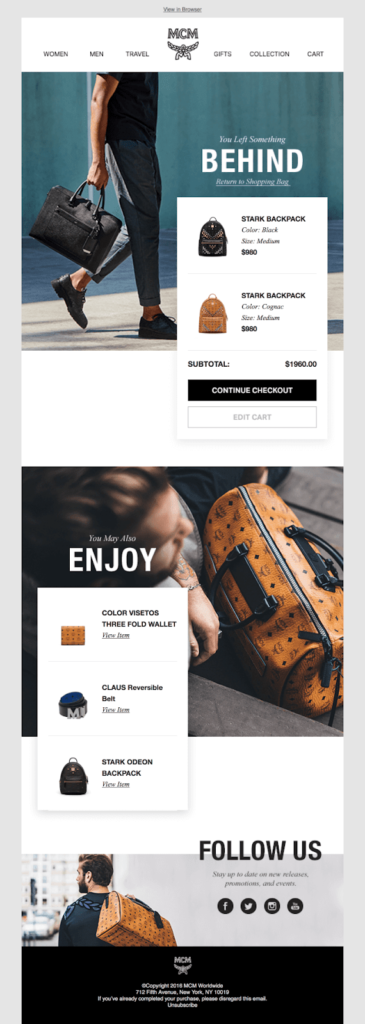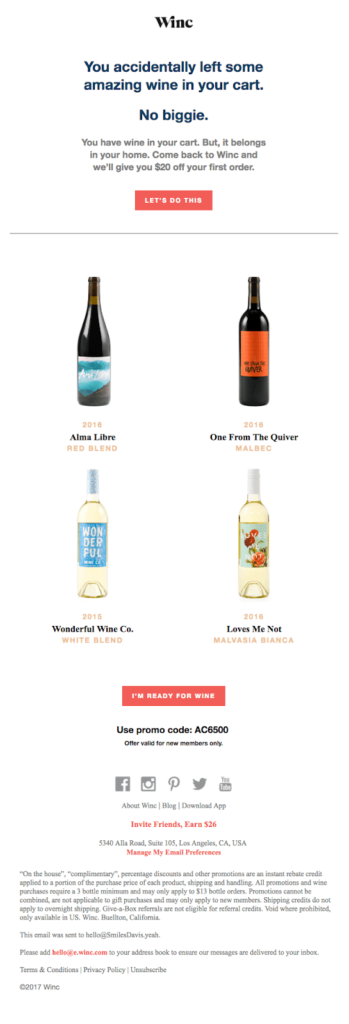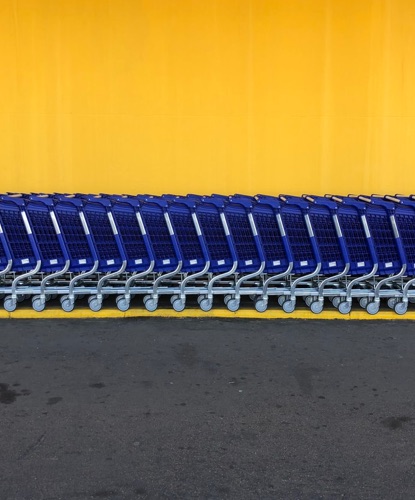Crafting abandoned cart emails that convert (+ examples & tips)
10 Minute Read

Crafting high converting abandoned cart emails is both an art and a science that requires consistent experimenting, testing, and optimization. We all know what an abandoned cart email is and why they’re important. But when was the last time you checked in and did a few tests to optimize it? Abandoned cart emails are not a set-it-and-forget-it type of email. While it is automated, and you don’t have to fiddle with it, it’s best to think of it as a constant work in progress. Not testing or experimenting with your abandoned cart emails is a surefire way to leave money on the table. Consistent testing can string together many small wins and a big increase in revenue generated.
The job of the abandoned cart email is to push shoppers from intent to conversion. But before we get into tactics, let’s take a step back and understand the root cause.
What’s causing your shoppers to abandon cart?
To get to the root, ask yourself, “why are my shoppers abandoning their carts in the first place?” The fact is that there’s a whole myriad of reasons why shoppers will abandon their carts — both intentional as well as unintentional reasons.
Intentional reasons for cart abandonment:
- Unexpected total cost
- Long or complicated checkout process
- Being forced to create an account
- Unexpected delivery costs
- Security concerns
- Comparison shopping
- Lack of payment options
The good news is that many of these issues are very addressable.
The overarching theme of many of these reasons is a lack of proactive communication. Clearly communicating how costs are calculated and what each line item is, explaining why creating an account is necessary and what the benefits are, showing payment security logos, and showing which payment options are available are a few examples of how to proactively communicate to shoppers.
Also think of ways to reduce friction and simplify in the process, like reducing the number of checkout steps, increasing available payment options, or including a guest checkout option.
Unintentional reasons for cart abandonment:
- Website crash
- Website timed out
- Distraction
- Credit card information not on hand
- Mistake in payment or billing information
- Internet cut out
There’s also good news with unintentional reasons for cart abandonment. Rather than viewing these reasons as uncontrollable factors, see them as opportunities to provide a great customer experience.
Website performance is an obvious, yet underutilized tactic to improve conversion. The key is being able to recognize and respond to performance issues. Auto-saving checkout progress and alerting shoppers in the browser when their session is close to timing out will benefit not only you but the shopper as well and reduce the chances of a negative brand experience.
Simple user experience improvements can also improve conversion by creating a more user-friendly and engaging experience that reduces distraction. We’ve even seen brands use a “remind me later with an email” option for shoppers who don’t have their credit card information on them.
Proactive prevention of abandoned carts:
- Exit intent form
- Add an email checkbox to your checkout process
Some additional ways to proactively prevent abandoned carts, or at least provide an opportunity to convert first-time shoppers, is to add an exit intent form on checkout pages and add an email checkbox where shoppers drop off most often.
What makes a great abandoned cart email?
Now that we have a solid understanding of why shoppers are abandoning their carts and some ways to take preventative action, let’s dig into how to recover abandoned carts and push shoppers from intent to conversion.
Subject line. As with every email, it all starts with the subject line. The subject line is the gatekeeper to your email and your first objection to converting abandoned cart items. The subject line is a great exercise of copywriting as you have to elicit a response with very limited size, style, and amount of words.
A bad subject line = little chance of converting. A great subject line = substantial chance of converting.
Focus on evoking an emotion. But not just any emotion. The three emotions you can capitalize on are joy, curiosity, and urgency. Tying an emotion to a glimpse of what’s inside the email make for a winning combination in every cart abandonment email subject line.
Use these examples for inspiration:
- Your {{item_name}} is feeling abandoned…
- Did you leave something behind?
- Hey {{first_name}}, you forgot something
- You forgot how much you want to buy this!
- Your items are getting lonely—check in with them
- Where did you go???
- Let’s make a deal
- Still thinking it over?
- Maybe this will change your mind?
Using personalization tokens like the shopper’s first name or cart items will greatly increase the relevance of the subject line.
If you have the ability to continually test subject lines in automated messages like you can in Cordial Experiments, keep testing new subject line ideas and optimize for highest converting one.
Abandoned cart items. Mention and show the abandoned cart items in as many places as are relevant. Unless you remind them, chances are that shoppers won’t even remember entering your site, much less what they were searching for initially.
Product image, size, color, pattern, etc. within the email is a great way to remind them of what they’re missing out. After all, they may not really remember what product they abandoned if they had a particularly busy “window shopping” day, such as on the Black Friday weekend.
Social proof. Social proof is also one of Robert Cialdini’s six principles of persuasion, which maintains that people are especially likely to perform certain actions if they can relate to the people who performed the same actions before them.
Reviews, testimonials, ratings, and quotes have long been a conversion tactic for marketers. Social proof reduces the risk of buying a product and increases the shopper’s confidence in their decision.
CTA (Call-To-Action). Use a single call-to-action or highlight one call-to-action above all others: buy the items already in their cart. Don’t distract users from the main action you want them to perform.
Bold and attractive CTAs can really grab the attention of the shopper and push them towards an action you want them to take. The button text should be something like “Continue shopping”, “Buy it now”, “Return to cart”, or something creative relating to the subject line or header of the email.
The offer. Include a low-risk offer to incentivize action. It’s no secret that we love free stuff and discounts. If you’re not already, try offering an incentive that is exclusive to the email and not something that everyone can get. You can also make it a limited time offer to create urgency and push someone to action sooner rather than later.
Common offers in abandoned cart emails include:
- Dollar discounts
- Percentage discounts
- Free shipping
- Free add-on item
Timing. The timing of your abandoned cart email is crucial if you want shoppers to complete their purchases. This is also why it’s so important to have strong and fast data integrations so that you can get the data you need when you need it.
At the latest, send your first email within 24 hours of them exiting your checkout so it’s still fresh in their mind. But many brands find that sooner is better. An email within the first 20 to 30 minutes is ideal to recapture attention and intent.
Product recommendations. Product recommendations serve two purposes for an abandoned cart email, increase average order value or offer shoppers who aren’t convinced with their current product choice a better one. The placement of the related items is critical as to not take attention away from the abandoned items. You can also consider showing similar items or showing complementary items, depending on the item type.
Include customer support information. Some shoppers may just need some help with their order, possibly due to confusion with checkout, a question about the product, or a payment issue. Include contact information like phone number, email address, live chat, or store locations if applicable. You may even want to test sending a plain text email from a customer support rep as a part of your cart abandonment series.
Add more emails. If your first email wasn’t successful at converting the shopper, try sending a second and third email. But like the advice above, make sure to get the timing right. The last thing you want to do is bombard shoppers with a bunch of conversion-focused emails in a short span of time. Leave ample time between messages.
A common cadence could look like this:
- 1st email 20-60 minutes after exiting checkout
- 2nd email 24 hours after the first email
- 3rd email 48 hours after the second email
Best abandoned cart email examples
Bonobos

An image with a man in a chicken costume is sure to get your attention. While they don’t directly show which items were left in the cart, the entertaining image suffices. The email has a very strong call-to-action and the entirety of the email is plainly understood very quickly.
MCM

This MCM email does a fantastic job of showing the abandoned items. What’s also unique about this email are the two buttons to either continue checkout or edit the cart. This addresses an important issue of a shopper possibly not buying because they need to pare down their order and don’t want to go through the trouble to remove an item. You’ll also notice that they’ve included a “you may also enjoy” section for upselling.
Beardbrand

This email from Beardbrand is an example of a very focused, straightforward email meant to convert shoppers. They first inform the shopper that their abandoned cart item will expire, then give a call-to-action to buy, then show the item, and then show another call-to-action to buy. The call-to-action repetition helps enforce the intent of the email and makes it crystal-clear what shoppers should do.
Massdrop

Massdrop is unique because of its business model, which is intrinsically focused on limited-time items. The call-to-action is to finish completing their purchase before the “drop” expires and the product is no longer available. This email also does a great job of showing many different product images.
Winc

Winc is a prime example of great copywriting: “You have wine in your cart. But, it belongs in your home.” The email shows many images of the abandoned cart items and also includes product details like year of the wine, the flavor, and the type of wine. There’s also the fun but easily understood call-to-action, “I’m ready for wine.”
In summary, when was the last time you checked your abandoned cart series? Abandoned cart emails are not a set-it-and-forget-it type of email. Be sure to look into why your shoppers are abandoning their carts in the first place, and then take the necessary steps to optimize your abandoned cart emails to push shoppers from intent to conversion.
Picked For You

How to effectively leverage experimentation in your marketing campaigns
Running a successful cross-channel marketing program requires more than just publishing content across your various…

Gen Z didn’t kill brand loyalty, but it looks different
Gen Z loves individuality. In fact, the one thing they might agree on is that…



